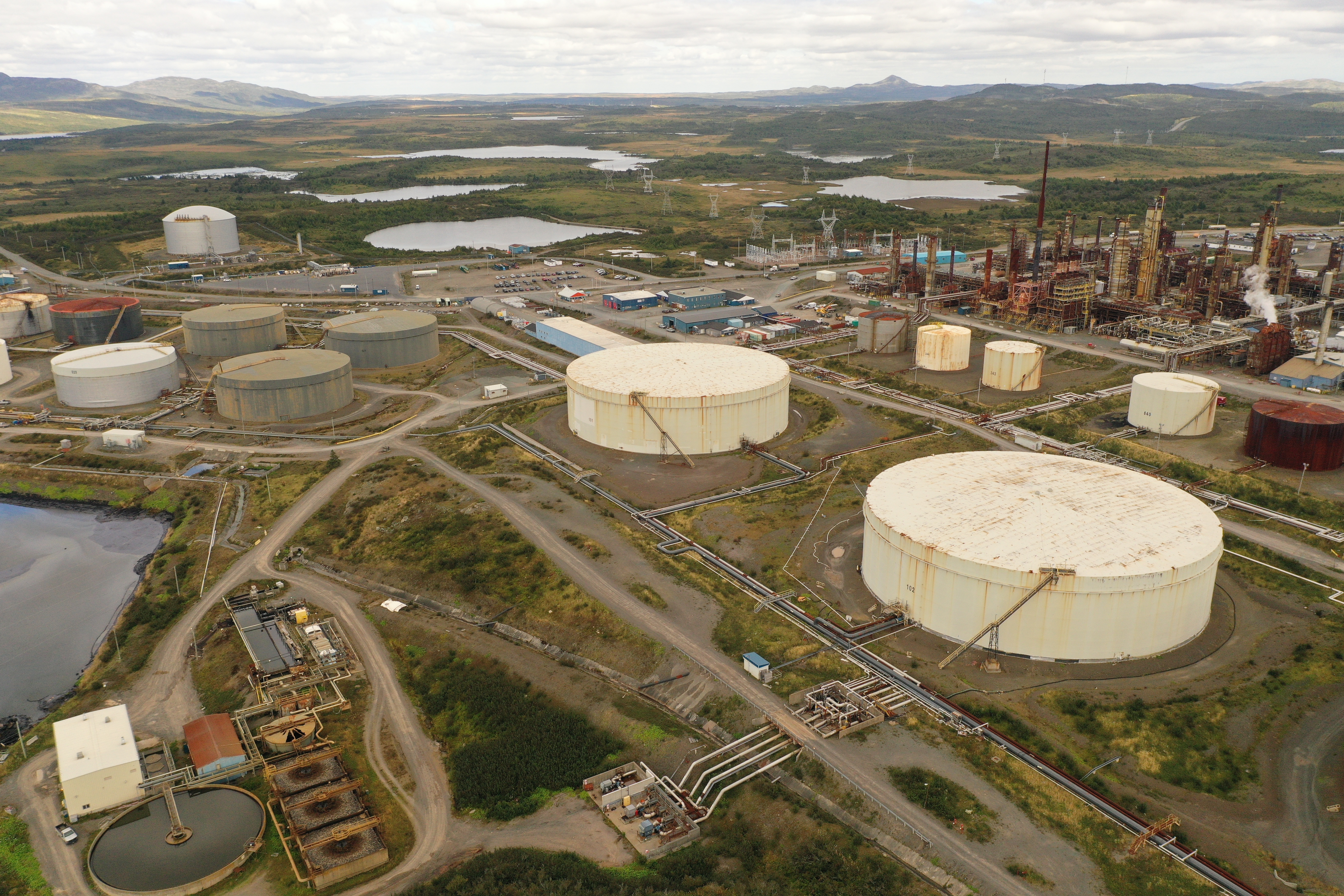November 9, 2021
It’s a fine day for a walk toward the edge of Placentia Bay.
The early fall weather is unseasonably warm. Cotton candy clouds dot the azure sky. A drone whirs to life, hangs in the air for a moment, then buzzes off into the distance, toward the Come By Chance oil refinery in eastern Newfoundland.
In 2014, internal provincial government documents described the large tanks here as the greatest environmental concern associated with refinery operations, pointing to past non-compliance with inspection requirements.
Plans were in the works to address that.
But on this sunny day seven years later, the drone’s unblinking eye seems to cast doubt on whether all of those plans became a reality.

The refinery is perched above Placentia Bay, where Jasmine Paul’s family has plied the waters for five generations in search of fish.
Paul, who lives in Come By Chance, has been working for the past few years as an apprentice harvester in the family enterprise.
She understands what the facility means to the economy. But she believes the environment is also important.
The CBC recently showed her some of the video that was captured by our drone earlier this fall.
Paul had previously seen satellite images of the refinery that appeared to show problems with this tank.
But nothing like this.
“Oh, that's bad. OK, so now I'm much more concerned,” Paul said.
“You can't see [in the Google satellite image] that the top is collapsed and there's some kind of black sludge in there. And what is that?”

She looks again at the video of the refinery’s tank.
In the same frame, she can see Long Beach Sunker, her main fishing mark — a geographical feature of the landscape that harvesters use to determine where to set their gear.
“That's fairly concerning,” Paul said.
The operators of the refinery declined interview requests but stressed in an emailed statement that they are living up to all of their responsibilities.
“We work with the appropriate government of Newfoundland and Labrador departments and are in compliance with all environmental requirements,” Silverpeak said in an email sent by Karen White of National Public Relations.
“As a private company, we do not comment about the details of our operations.”
The Newfoundland and Labrador Environment Department said the refinery has complied with its certificate of approval.
“Any non-compliance issues posing any direct environmental impacts have been addressed through their compliance agreement,” the department said in an emailed statement.
As for that tank, the province said in a statement it has been out of service since 2014.
“As product has been removed from the tank, the Department of Environment and Climate Change has determined that there is no environmental concern.”
The department later clarified that remaining material would be in the form of sludge in the tank bottom that “would not be mobile under normal ambient temperatures.”
The department did not make anyone available for an interview, over a period of several weeks.
The tale of Tank 106
There were problems with Tank 106 all the way back in 2014. According to government documents, it was taken out of service to assess repairs.
At the time, new owners were looking to take over the refinery, and informed the province of their capital expenditure, or capex, plans.
“Tank 106 will be repaired immediately,” SilverRange Financial Partners told the government in a June 2014 presentation.
SilverRange — the energy and natural resources division of New York-based alternative investment management firm Silverpeak — said $9 million would be spent to complete that work on Tank 106 by the end of 2015.
Fast-forward to the fall of 2021.

The drone hovers near the top of Tank 106, its high-definition camera capturing images of what is inside.
It can do that because the roof of the nearly 20-metre-high tank is partially collapsed, ripped and crumpled like a pop can.
There is debris embedded in what looks like a black sludge-like substance below.
‘Ecologically and biologically significant area’
Gail Fraser, a biologist who has researched the management of offshore oil and gas, explained to CBC News what could happen in a worst-case scenario — if hydrocarbons were ever to leak into the waters below.
“It's a really difficult terrain to be monitoring the impacts of a spill,” said Fraser, a professor with the faculty of environmental and urban change at York University.
“There’s large cliffs and lots of islands, lots of complicated coastline to be trying to figure out where oil went, and certainly birds could be killed.”

According to Fraser, the nearby waters are home to a diverse array of organisms, including a wide variety of seabirds and whales.
Some of them are considered species at risk, she noted, and fishing communities could also be affected.
“One of the concerns for Placentia Bay is that it's an ecologically and biologically significant area,” Fraser said.
Inspection ‘non-compliance’ biggest concern
The history of the refinery goes back around half a century.
Environmental concerns there aren’t anything new, according to government documents written seven years ago, while the facility was under prior ownership.
“From [the Environment Department’s] perspective, the greatest environmental concern associated with the refinery operations is their non-compliance with the inspection requirements for their petroleum storage tanks,” advised a February 2014 internal government briefing note, obtained by CBC News through an access-to-information request.
“The NARL refinery has [amount redacted] in outstanding environmental obligations pertaining to their fuel storage and handling. These obligations are not due to new regulatory requirements, but rather are the result of the refinery falling behind in its regulatory obligations over the past 20 years.”
Another briefing note written soon after advised that “many of NARL’s tanks have not been inspected since their installation 40 years ago.”
But there was a solution in the works.

The refinery’s previous owner had committed to spending tens of millions over the subsequent three years to inspect, repair and upgrade their crude storage tanks.
But that company wanted out of the money-losing enterprise, and SilverRange spent much of 2014 kicking the tires on the Newfoundland refinery.
As part of that process, the company submitted a 22-page business proposal outlining planned investments to address concerns about the tanks.
That document was eventually included as part of the memorandum of agreement on environmental issues signed by the company and the province.
“SilverRange intends to operate a safe and efficient tank farm with the following principles: 1) No leaks 2) compliance with inspection intervals and 3) operational risk assessment,” the incoming owners said in that June 2014 business proposal.
There was an overall plan to spend $45 million on tank work by the end of 2016, including that $9 million to fix Tank 106.
Today, the company isn’t answering questions about how those plans progressed after it took over at Come By Chance.
Some inspections not up to date, or previously ‘unknown’ to province
It's not clear just how strict the province's oversight has been.
According to the environment department, eight of the in-service tanks do not have up-to-date internal inspections on file with the province.
As of two weeks ago, the inspection status of another 14 in-service tanks was “currently unknown” to the province.
Since CBC News asked, the department has tried to find out more information.
The department now says three of those 14 have met the standard.
There are reports from the refinery for the other 11 saying they are up to date, but the reports need further review and validation.
Officials also noted that the refinery has an on-site secondary containment system designed to capture and contain any product, if a tank should leak or fail.
‘The minimum requirement for safe operation’
That industry standard — API 653 — outlines inspection requirements for above-ground storage tanks like those at Come By Chance.
“This standard is important because this will give you the minimum requirement for safe operation,” said Jacob Muthu, an assistant professor in the petroleum systems engineering program at the University of Regina.
CBC showed Muthu some of the drone video of Tank 106, to get his input on what he saw.
“That failure looks really very bad, in my opinion. That is not the way it has to be,” Muthu said.
“Leaving those tanks idle, that's not going to help anybody. So either it needs to be repaired and then put it in use or it needs to be scrapped completely.”

Rewind again to 2014, the last time the refinery changed hands.
A key part of the sale process was a provincial indemnity for certain pre-existing environmental liabilities — relating to soil, sediment, groundwater and surface water at the site of the refinery.
It followed two other arrangements made with previous owners decades earlier.
“We had a choice to make as a government, I guess, to accept some of these liabilities or the refinery would likely shut down and 600 men and women will be out of work,” then natural resources minister Derrick Dalley said in a September 2014 interview with CBC News.
“So we feel it's a good decision for the refinery and the asset for the province. It's great for the employees and we're comfortable with the liabilities. We're doing a complete environmental assessment.”
That complete environmental assessment was due within a year after the deal closed in late 2014. Senior government officials said it would be released when finished.
But today, the report is still not finalized. And now the government says it will be off limits to the public, whenever it’s done.
Neither Silverpeak nor the province would talk about whether the tank farm could be included in any future deal.
But an internal government briefing note from six months ago said the refinery “has requested an extension and amendment of the environmental indemnity.”
The province has been keeping its cards close to the chest about the past environmental indemnity, as well as what could happen next.
“Without putting myself into trouble here, the environment is a component of any deal of this nature when we're talking about resources. So that's one part I can't get into too much,” Energy Minister Andrew Parsons told CBC News in August.
“But let's just say that, you know, obviously we're cognizant of what is there, what the liabilities are. And, you know, we have to keep an eye on this. So that's just one component that the province would have an interest in.”
‘Warm idle’ mode during search for buyer
The economic shockwave of COVID-19 knocked the North Atlantic refinery out of production in March 2020.
The owners put the facility on the market.
Later that year, a deal with Irving fell apart, and overtures from another suitor, Origin International, were rejected.
Then, in January, hours before the provincial election call, the Furey administration announced a $16.6-million cash infusion for the refinery, to keep it in “warm idle” mode while the hunt for a new owner continued.
Now, a deal with Cresta Fund Management — a Texas-based private equity firm that plans to convert the refinery to produce renewable fuels — appears to be in the final stages.
Back in Come By Chance, the fishing season is over for Jasmine Paul.
She is stacking wood for the coming winter, and wondering what comes next.
“If the province is going to continue to support the refinery to keep jobs, then we also need to make sure that we're thinking about the future and the environment as well.”
